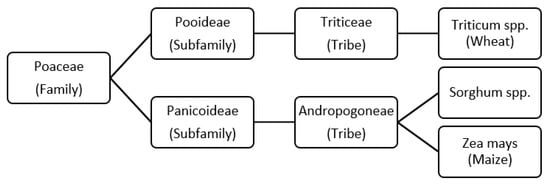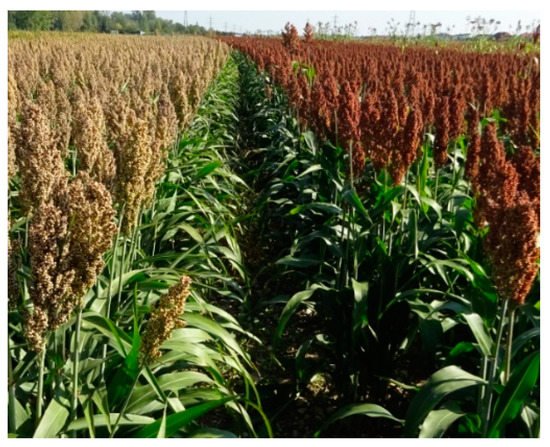Due to the extreme weather conditions, caused by the climate change, the usual wheat harvest yield and quality in the Western countries were difficult to maintain in the past few years. The altered wheat quality was primarily characterized by a rising protein content. The application of high protein wheat flours in baking products leads to baking difficulties due to its elastic dough behavior. As these issues will further face the Western cereal cultivation, heat resistant cereals, like sorghum, are attracting increasing interest. A partial substitution of wheat with sorghum might offer one possible solution to address the current challenging situation. To introduce sorghum in the Western cereal and baking industry, the grain and its unique chemical and rheological properties need to be more widely promoted. Until now, several authors have conducted studies in order to emphasize the high potential of sorghum. The aim of the present review is to broaden the current knowledge of the chemical, rheological and baking properties of sorghum in comparison to wheat.
- sorghum
- western bread
- rheology
- baking
- wheat sorghum blends
1. Introduction
2. Classification and Morphology of Sorghum


3. Chemical and Nutritional Properties of Sorghum
3.1. Protein
3.2. Carbohydrate
3.3. Fat
3.4. Micronutrients
3.5. Secondary Plant Products
This entry is adapted from the peer-reviewed paper 10.3390/foods10061392
References
- Trnka, M.; Feng, S.; Semenov, M.A.; Olesen, J.E.; Kersebaum, K.C.; Rötter, R.P.; Semerádová, D.; Klem, K.; Huang, W.; Ruiz-Ramos, M. Mitigation efforts will not fully alleviate the increase in water scarcity occurrence probability in wheat-producing areas. Sci. Adv. 2019, 5, eaau2406.
- Gagliardi, A.; Carucci, F.; Masci, S.; Flagella, Z.; Gatta, G.; Giuliani, M.M. Effects of genotype, growing season and nitrogen level on gluten protein assembly of durum wheat grown under mediterranean conditions. Agronomy 2020, 10, 755.
- Salim-ur-Rehman Ahmad, M.; Bhatti, I.; Shafique, R.; Mueen-ud-Din, G.; Murtaza, M. Effect of pearling on physico-chemical, rheological characteristics and phytate content of wheat-sorghum flour. Pak. J. Bot. 2006, 38, 711–719.
- Rizk, I.R.; Hemat, E.E.; Gadallah, E.; Abou-Elazm, M.; Bedeir, H. Quality characteristics of sponge cake and biscuit prepared using composite flour. J. Agric. Soc. Sci. 2015, 23, 537–547.
- Istianah, N.; Ernawati, L.; Anal, A.K.; Gunawan, S. Application of modified sorghum flour for improving bread properties and nutritional values. Int. Food Res. J. 2018, 25, 166–173.
- Ognean, C.-F. Technological and sensorial effects of sorghum addition at wheat bread. Agric. Food 2015, 3, 209–217.
- Sibanda, T.; Ncube, T.; Ngoromani, N. Rheological properties and bread making quality of white grain sorghum-wheat flour composites. Int. J. Food Sci. Nutr. Eng. 2015, 5, 176–182.
- Osman, M.A.; Gassem, M. Effects of domestic processing on trypsin inhibitor, phytic, acid, tannins and in vitro protein digestibility of three Sorghum varieties. Int. J. Agric. Technol. 2013, 9, 1187–1198.
- Emmambux, M.N.; Taylor, J.R.N. Properties of heat-treated sorghum and maize meal and their prolamin proteins. J. Agric. Food Chem. 2009, 57, 1045–1050.
- Hamaker, B.R.; Bugusu, B.A. Workshop on the Proteins of Sorghum and Millets: Enhancing Nutritional and Functional Properties for Africa [CD]; Scientific Research: Pretoria, South Africa, 2003.
- Cruickshank, A. Sorghum grain, its production and uses: Overview. In Encyclopedia of Food Grains, 2nd ed.; Wrigley, C., Corke, H., Seetharaman, K., Faubion, J., Eds.; Academic Press: Oxford, UK, 2015; pp. 153–158.
- Taylor, J.R.N. Sorghum and millets: Taxonomy, history, distribution, and production. In Sorghum and Millets: Chemistry, Technology, and Nutritional Attributes, 2nd ed.; Taylor, J., Duodu, K.G., Eds.; Elsevier: Amsterdam, The Netherlands, 2019; pp. 1–21.
- Awika, J.M.; McDonough, C.M.; Rooney, L.W. Decorticating sorghum to concentrate healthy phytochemicals. J. Agric. Food Chem. 2005, 53, 6230–6234.
- Taylor, J.R.N. Overview: Importance of sorghum in Africa. In Proceedings of the Workshop on the Proteins of Sorghum and Millets: Enhancing Nutritional and Functional Properties for Africa, Pretoria, South Africa, 2–4 April 2003.
- Rumler, R.; Bender, D.; Speranza, S.; Frauenlob, J.; Gamper, L.; Hoek, J.; Jäger, H.; Schönlechner, R. Chemical and physical characterization of sorghum milling fractions and sorghum whole meal flours obtained via stone or roller milling. Foods 2021, 10, 870.
- Seleem, H.A.; Omran, A.A. Evaluation quality of one layer flat bread supplemented with beans and sorghum baked on hot metal surface. Food Nutr. Sci. 2014, 5, 2246–2256.
- Tasie, M.M.; Gebreyes, B.G. Characterization of nutritional, antinutritional, and mineral contents of thirty-five sorghum varieties grown in Ethiopia. Int. J. Food Sci. 2020, 2020, 1–11.
- Galán, M.G.; Llopart, E.E.; Drago, S.R. Losses of nutrients and anti-nutrients in red and white sorghum cultivars after decorticating in optimised conditions. Int. J. Food Sci. Nutr. 2017, 69, 283–290.
- Yousif, A.; Nhepera, D.; Johnson, S. Influence of sorghum flour addition on flat bread in vitro starch digestibility, antioxidant capacity and consumer acceptability. Food Chem. 2012, 134, 880–887.
- Srichuwong, S.; Curti, D.; Austin, S.; King, R.; Lamothe, L.; Gloria-Hernandez, H. Physicochemical properties and starch digestibility of whole grain sorghums, millet, quinoa and amaranth flours, as affected by starch and non-starch constituents. Food Chem. 2017, 233, 1–10.
- Taylor, J.R.N.; Schussler, L.; van der Walt, W.H. Fractionation of proteins from low-tannin sorghum grain. J. Agric. Food Chem. 1984, 32, 149–154.
- Belton, P.S.; Delgadillo, I.; Halford, N.G.; Shewry, P.R. Kafirin structure and functionality. J. Cereal Sci. 2006, 44, 272–286.
- Mohapatra, D.; Patel, A.S.; Kar, A.; Deshpande, S.S.; Tripathi, M.K. Effect of different processing conditions on proximate composition, anti-oxidants, anti-nutrients and amino acid profile of grain sorghum. Food Chem. 2019, 271, 129–135.
- Gassem, M.A.A.; Osman, M.A. Proximate composition and the content of sugars, amino acids and anti-nutritional factors of three sorghum varieties. Agric. Res. Cent. King Saud Univ. Res. Bull. 2003, 125, 5–19.
- Emmambux, N.M.; Taylor, J.R.N. Sorghum kafirin interaction with various phenolic compounds. J. Sci. Food Agric. 2003, 83, 402–407.
- Pontieri, P.; Di Fiore, R.; Troisi, J.; Bean, S.R.; Roemer, E.; Okot, J.; Alifano, P.; Pignone, D.; Del Giudice, L.; Massardo, D.R. Chemical composition and fatty acid content of white food sorghums grown in different environments. Maydica 2011, 56, 1–7.
- Sang, Y.; Bean, S.; Seib, P.A.; Pedersen, J.; Shi, Y.-C. Structure and functional properties of sorghum starches differing in amylose content. J. Agric. Food Chem. 2008, 56, 6680–6685.
- Singh, H.; Sodhi, N.S.; Singh, N. Characterisation of starches separated from sorghum cultivars grown in India. Food Chem. 2010, 119, 95–100.
- Miafo, A.-P.T.; Koubala, B.B.; Kansci, G.; Muralikrishna, G. Free sugars and non-starch polysaccharides–phenolic acid complexes from bran, spent grain and sorghum seeds. J. Cereal Sci. 2019, 87, 124–131.
- MartinoI, H.S.D.; Tomaz, P.A.; Moraes, É.A.; ConceiçãoI, L.L.d.; Oliveira, D.d.S.; Queiroz, V.A.V.; Rodrigues, J.A.S.; Pirozi, M.R.; Pinheiro-Sant’Ana, H.M.; Ribeiro, S.M.R. Chemical characterization and size distribution of sorghum genotypes for human consumption. Rev. Inst. Adolfo Lutz (Impresso) 2012, 71, 337–344.
- Moraes, É.A.; Marineli, R.d.S.; Lenquiste, S.A.; Steel, C.J.; Menezes, C.B.d.; Queiroz, V.A.V.; Maróstica Júnior, M.R. Sorghum flour fractions: Correlations among polysaccharides, phenolic compounds, antioxidant activity and glycemic index. Food Chem. 2015, 180, 116–123.
- Osman, R.O.; Abd El-Gelil, F.M.; El-Noamany, H.M.; Dawood, M.G. Oil content and fatty acid composition of some varieties of barley and sorghum grains. Grasas Y Aceites 2000, 51, 157–162.
- Meera, M.S.; Bhashyam, M.K.; Ali, S.Z. Effect of heat treatment of sorghum grains on storage stability of flour. LWT-Food Sci. Technol. 2011, 44, 2199–2204.
- Motlhaodi, T.; Bryngelsson, T.; Chite, S.; Fatih, M.; Ortiz, R.; Geleta, M. Nutritional variation in sorghum [Sorghum bicolor (L.) Moench] accessions from southern Africa revealed by protein and mineral composition. J. Cereal Sci. 2018, 83, 123–129.
- Makawi, A.B.; Mustafa, A.I.; Adiamo, O.Q.; Mohamed Ahmed, I.A. Physicochemical, nutritional, functional, rheological, and microbiological properties of sorghum flour fermented with baobab fruit pulp flour as starter. Food Sci. Nutr. 2019, 7, 689–699.
- Girard, A.L.; Awika, J.M. Sorghum polyphenols and other bioactive components as functional and health promoting food ingredients. J. Cereal Sci. 2018, 84, 112–124.
- Beta, T.; Corke, H.; Rooney, L.W.; Taylor, J.R.N. Starch properties as affected by sorghum grain chemistry. J. Sci. Food Agric. 2000, 81, 245–251.
- Serna-Saldivar, S.O.; Espinosa-Ramírez, J. Grain structure and grain chemical composition. In Sorghum and Millets; Elsevier: Amsterdam, The Netherlands, 2019; pp. 85–129.
- Wedad, H.A.; El Tinay, A.H.; Mustafa, A.I.; Babiker, E.E. Effect of fermentation, malt-pretreatment and cooking on antinutritional factors and protein digestibility of sorghum cultivars. Pak. J. Nutr 2008, 7, 335–341.
- Przybylska-Balcerek, A.; Frankowski, J.; Stuper-Szablewska, K. Bioactive compounds in sorghum. Eur Food Res. Technol 2019, 245, 1075–1080.
